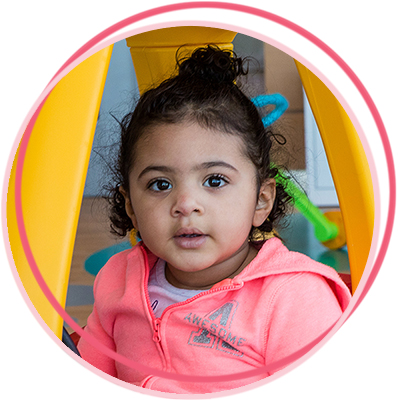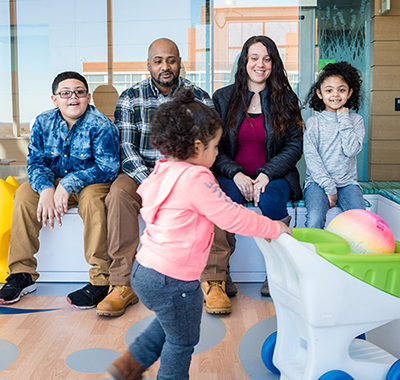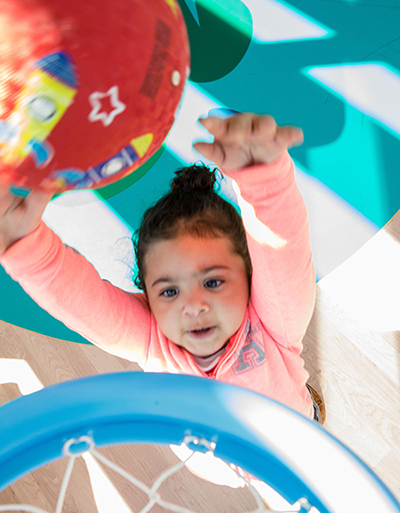Halani Rolle
Infant Beats Rare Cancer with Help from Her Big Sister
 By the time 4-month-old Halani Rolle arrived at Golisano Children’s Hospital, she was pale, seemed to be in pain, wasn’t eating, and had bruising on her left cheek and stomach.
By the time 4-month-old Halani Rolle arrived at Golisano Children’s Hospital, she was pale, seemed to be in pain, wasn’t eating, and had bruising on her left cheek and stomach.
She’d been transferred from a Buffalo hospital for a bone marrow transplant — her best chance of a cure for what had been diagnosed four months earlier as acute myeloid leukemia, a type of blood cancer that starts in the bone marrow. Halani’s prognosis was poor. AML in infants is extremely rare and generally aggressive, with modest cure rates. Infant bodies are fragile and prone to toxic side effects. In Halani’s case, a specific genetic mutation made the disease even more rare, more aggressive and more difficult to treat.
Her chance of survival: about 20 percent.
Doctors at Golisano Children’s Hospital see cases like hers once or twice in a decade, according to Jeffrey R. Andolina, M.D., a pediatric hematologist-oncologist and director of Pediatric Bone Marrow Transplantation at Golisano Children’s Hospital.
“When your child gets diagnosed with cancer, the first thing that hits you is fear, then anger,” said her father, Jason Rolle. “You see commercials on television for places that treat kids with cancer, but you take them for granted. Then you’re faced with, ‘Why my child?’”
A High-Risk Case
At first, Halani’s pediatrician thought she had an upper respiratory infection. But after Jason and Crystal Andreassen, Halani’s mother, brought her back to his office, tests showed she had a white blood cell count of 583,000. It should have been between 4,000 and 10,000.
Halani spent the next three days in the neonatal intensive care unit in Buffalo, while her parents attended one meeting after another with doctors to learn about, and try to process, what was happening with their daughter.
“She was hooked up to a bunch of machines,” said Crystal. “There were a lot of doctors and nurses running about. I was just scared and numb.”
Considered a high-risk patient, Halani had three rounds of strong chemotherapy and bone marrow biopsies over the next several months. Her hair began to fall out and she mostly slept.
Despite the intensity of her treatment, it wasn’t strong enough. Halani needed a bone marrow transplant, also known as a stem cell transplant. A matched sibling is the most optimal donor, so Halani’s 8-year-old brother, Julian, and 5-year-old sister, Harlem, had what’s called HLA typing — HLA stands for human leukocyte antigen — to find out whether either of them had a similar tissue type. The blood test, a way to tell how closely the tissues of one person match the tissues of another person, discovered that Harlem was a perfect match. A perfect match happens only in one out of every four cases in full siblings.
“We sat Harlem down and told her how important this was, and what it would do for Halani,” Crystal recalled. “The day they took her into the operating room and put the mask on her face, we both cried together.
“But when she woke up,” she added, “we went to the park and she went swinging.”
As part of the bone marrow transplant process, Halani received chemotherapy for seven days straight. The high doses required for her treatment plan led to an uncommon complication called veno-occlusive disease of the liver, which happens when small vessels that transport blood through the liver become blocked. The condition caused her to develop an enlarged liver, known as hepatomegaly. Her liver then caused her abdomen to become distended, making her very uncomfortable.
Thankfully, her liver problems improved with good, supportive care, including potent diuretics to reduce the extra fluid in her body.
Over time, as Halani healed from the transplant and adapted to her sister’s stem cells, every one of her liver tests — and the size of her liver — improved and ultimately recovered completely.
“There were no surprises, no last-minute decisions,” said Crystal. “Dr. Andolina and the nurses were so respectful. We knew everything as they knew everything.”

Halani with her parents, Crytal and Jason, and siblings Julian and Harlem.
More Hurdles
There would be more to learn.
Radiation often is used in AML cases, but because exposure in infants has been linked with learning disabilities, her medical team decided to do spinal taps with chemotherapy—every two weeks for six months — to address the leukemia in her spinal fluid.
“It’s unusual to do any spinal taps after a bone marrow transplant, and even more unusual to do 12,” said Andolina.
That number may have been arbitrary, but Halani’s treatment was so successful that her oncology team used her exact care plan six months later on a second infant with AML — another unusual situation — to similarly successful results so far.
There was, in fact, one last hurdle to face before going home. Halani was put on an immunosuppressive medicine for nearly six months to make her body less likely to reject her new bone marrow. Even so, she developed a mild case of graft-versus-host disease, a common complication. Harlem’s immune cells started attacking Halani’s healthy cells, which they saw as foreign, resulting in an itchy rash.
After being treated with Prednisone, Halani — after spending five weeks at Golisano Children’s Hospital — was able to go home.
At that point she had spent half of her life in a hospital room.

Happy and Active and Wild
‘Happy and Active and Wild’
Even now at 18 months past her transplant date, Halani has retained the same sleeping schedule she kept at Golisano Children’s Hospital: in bed between 11 p.m. and midnight, sleeping late into the morning.
“The nurses treated her like she was their own, and I think them spoiling her contributed to her terrible twos,” joked Crystal. “Harlem tells her all the time, ‘Halani, I saved your life. You have to listen to me.’”
Now 2 years old, Halani returns to Golisano Children’s Hospital every three months for bloodwork and vaccinations. She needs her vaccinations repeated because after the transplant, her immune system reverted back to that of a newborn baby. It takes between six months to one year after a bone marrow transplant for a patient’s immune system to slowly start forming again.
With a personality as bouncy as her dark curls, Halani tends to be all smiles.
“She comes in and runs around, screaming,” said Andolina. “She’s happy and active and wild. It’s so nice to see she didn’t have any side effects from the treatments.”
In fact, Andolina considers her cured.
Halani loves to swing at the playground, read My Little Pony books, and sing along to animated penguin shows on YouTube.
“She’s like a normal child now,” Crystal said.
Said Jason: “This just makes you appreciate everything you have. Even if you don’t have a lot, it makes you feel like you have a lot.”
Make a Gift to Golisano Children's Hospital